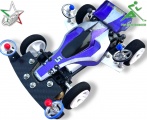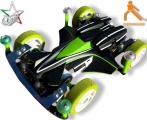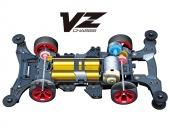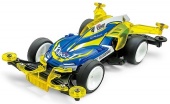Differenze tra le versioni di "Pagina principale/en"
(Creata pagina con "<div class="row mb-4"> ==What the Street Mini 4WD is?==") |
(Creata pagina con "The first mini 4WD in history, the Stomper 4x4, was created by Adolph Goldfarb and produced by the american [https://en.wikipedia.org/wiki/Schaper_Toys Schaper] in 1980. Subse...") |
||
| Riga 49: | Riga 49: | ||
The term "mini 4WD" is used to identify a category of racing model car. | The term "mini 4WD" is used to identify a category of racing model car. | ||
| − | + | The first mini 4WD in history, the Stomper 4x4, was created by Adolph Goldfarb and produced by the american [https://en.wikipedia.org/wiki/Schaper_Toys Schaper] in 1980. Subsequently, in 1982, the Japanese company [http://www.tamiya.com Tamiya] marketed its first four-wheel drive model cars: the first series of model cars called "mini 4WD" was born. However, it was with the third series of Tamiya mini 4WDs, the Racing Mini 4WD (1986), that these model cars took on the meaning of racing cars. | |
| − | The first mini 4WD in history, the Stomper 4x4, was created by Adolph Goldfarb and produced by the american [https://en.wikipedia.org/wiki/Schaper_Toys Schaper] | ||
The main features that make a model car a mini 4WD are: | The main features that make a model car a mini 4WD are: | ||
| Riga 59: | Riga 58: | ||
* Although there are mechanisms that allow mini 4WDs to steer on certain occasions, these cars always go straight; | * Although there are mechanisms that allow mini 4WDs to steer on certain occasions, these cars always go straight; | ||
| − | + | E' possibile controllare la corsa di una mini 4WD in due modi: | |
| − | |||
| − | |||
| − | |||
| − | |||
* Using the mini 4WD inside a specially made track. A mini 4WD track is made up of an n number of lanes (2, 3 or 5), each lane is delimited by "walls" (also called "sides" or "edges") that allow a mini 4WD to complete a specific route . A mini 4WD is physically "forced" by the wall (during a curve for example) to follow the path of the wall itself; | * Using the mini 4WD inside a specially made track. A mini 4WD track is made up of an n number of lanes (2, 3 or 5), each lane is delimited by "walls" (also called "sides" or "edges") that allow a mini 4WD to complete a specific route . A mini 4WD is physically "forced" by the wall (during a curve for example) to follow the path of the wall itself; | ||
| Riga 73: | Riga 68: | ||
Both possibilities are based on the same principle: the execution of a route by "constraint" through static deviations (the walls of a track) or dynamic ones (the blade of a guide stick). | Both possibilities are based on the same principle: the execution of a route by "constraint" through static deviations (the walls of a track) or dynamic ones (the blade of a guide stick). | ||
| + | <div class="mw-translate-fuzzy"> | ||
This wiki is about '''Street Mini 4WD racing'''. | This wiki is about '''Street Mini 4WD racing'''. | ||
</div> | </div> | ||
</div> | </div> | ||
| − | |||
| − | |||
</div> | </div> | ||
Versione delle 17:59, 8 apr 2024
What the Street Mini 4WD is?
"Street Mini 4WD" (Japanese: "ストリートミニ四駆") is a racing sport activity in which Mini 4WDs compete primarily off conventional tracks, most often through the use of a club: "the guide stick".
Born in Italy in 1994' and and affiliate CSEN dal 2023, the Street Mini 4WD is now universally recognised.
Summary
| History |
| Generic Topics |
| Tech Topics
How to drive · Tyres · Batteries · Motors · Mechanics · Setup · Chassis · Physics · Suspensions project · Plastic materials · 3D Printing |
| Tutorials |
| Races |
| Contacts |
What is a mini 4WD?
The term "mini 4WD" is used to identify a category of racing model car.
The first mini 4WD in history, the Stomper 4x4, was created by Adolph Goldfarb and produced by the american Schaper in 1980. Subsequently, in 1982, the Japanese company Tamiya marketed its first four-wheel drive model cars: the first series of model cars called "mini 4WD" was born. However, it was with the third series of Tamiya mini 4WDs, the Racing Mini 4WD (1986), that these model cars took on the meaning of racing cars.
The main features that make a model car a mini 4WD are:
- All-wheel drive (4 wheels drive);
- 1/32 scale;
- Movement and electrical power supply by means of a FA-130 motorand 2 AA 1.2/1.5v batteries;
- Although there are mechanisms that allow mini 4WDs to steer on certain occasions, these cars always go straight;
E' possibile controllare la corsa di una mini 4WD in due modi:
- Using the mini 4WD inside a specially made track. A mini 4WD track is made up of an n number of lanes (2, 3 or 5), each lane is delimited by "walls" (also called "sides" or "edges") that allow a mini 4WD to complete a specific route . A mini 4WD is physically "forced" by the wall (during a curve for example) to follow the path of the wall itself;
- The use of a club called "guide stick": a long rod made up of a grip area and a "paddle". This tool is very similar to a hockey stick, but is generally much lighter. During its travel the mini 4WD is "diverted" from the corridor via the steering lever, to do this the driver must therefore run behind the mini 4WD and control its movements in real time.
Both possibilities are based on the same principle: the execution of a route by "constraint" through static deviations (the walls of a track) or dynamic ones (the blade of a guide stick).
This wiki is about Street Mini 4WD racing.








